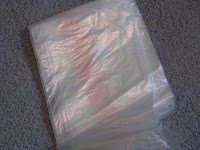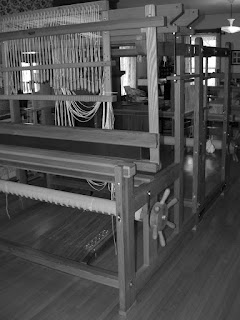Dissolving Arts and Crafts
 This project is inspired by Chrissy, an artist hanging on in Geraldine, New Zealand. She gave me the Solve bags and the general instructions. She explained that this soft pliable plastic-like material is made from corn starch. Oce immersed in warm water, the material dissolves away.
This project is inspired by Chrissy, an artist hanging on in Geraldine, New Zealand. She gave me the Solve bags and the general instructions. She explained that this soft pliable plastic-like material is made from corn starch. Oce immersed in warm water, the material dissolves away. With the first dumping of snow coming down around me today, I pulled out the equipment I'd need. I had several types of yarn from New Zealand I wanted to use in this first attempt of a shawl that dissolves away. The 3D glasses are optional.
With the first dumping of snow coming down around me today, I pulled out the equipment I'd need. I had several types of yarn from New Zealand I wanted to use in this first attempt of a shawl that dissolves away. The 3D glasses are optional. First, banish the dog to the hallway and cut open one bag. Lay flat.
First, banish the dog to the hallway and cut open one bag. Lay flat. Start with the black possum and sheep wool product. I just pulled from the centre of the ball and enjoyed the angular "scribblings". A random pattern works best. I laid down some white wool boucle after that.
Start with the black possum and sheep wool product. I just pulled from the centre of the ball and enjoyed the angular "scribblings". A random pattern works best. I laid down some white wool boucle after that. I looked across the room and my eye caught a silk and yak wool hank I had on the shelf. It begged to be included, and so I had to divert and wind the hank into a ball. I had no clear spot to stand, so it was a bit of a Twister move to accomplish this.
I looked across the room and my eye caught a silk and yak wool hank I had on the shelf. It begged to be included, and so I had to divert and wind the hank into a ball. I had no clear spot to stand, so it was a bit of a Twister move to accomplish this. Keep adding your yarns. Fine threads, satiny ribbon yarns. Whatever. you could really go wild and dense here if you want.
Keep adding your yarns. Fine threads, satiny ribbon yarns. Whatever. you could really go wild and dense here if you want. Open up another Solve bag and lay over top of everything.
Open up another Solve bag and lay over top of everything. Make sure you have a silly large amount of pins and go at it. Pinning all the way through the layers.
Make sure you have a silly large amount of pins and go at it. Pinning all the way through the layers. Here we are, ready for the sewing machine. But dogs need walking and people need feeding.
Here we are, ready for the sewing machine. But dogs need walking and people need feeding.
Start sewing. I first ran a line all the way around the outer edges, trying to catch most of the outermost loops. Then pick a point along this edge (anywhere) and pretend you are a billiard ball. Stitch across in diagonal patterns. When you reach the other side, pass over that framing line you did at the start, set the needle, spin the fabric, and off you go on another diagonal again. I don't think you need to be too precise or neat. (Okay, for my first time doing this, I think it would be hard to be precise and neat.) This part takes awhile. I found I could go a long time like a deflecting cue ball. Once you start to see a bunch of already sew lines around you, it's best to cut the thread, hold up the piece and look for any areas where you don't have enough coverage. I'd say if the stitch lines are about 7 cm apart, you'll be alright. (this from various examples of this lovely art that I saw in New Zealand).
 Remove pins and sigh as you view this lumpy mess.
Remove pins and sigh as you view this lumpy mess. Now, if a shot of whiskey will help.........................go for it. I was brave enough to toss right into the tub. Allow warm water to fill the tub. The corn starch material dissolves away, but not quickly. It is very much a mucous, slimey mess. Way more slime than threads and yarns.
Now, if a shot of whiskey will help.........................go for it. I was brave enough to toss right into the tub. Allow warm water to fill the tub. The corn starch material dissolves away, but not quickly. It is very much a mucous, slimey mess. Way more slime than threads and yarns. Not as bad as a pack of arctic wolves on a fallen muskox, but pretty ugly.
Not as bad as a pack of arctic wolves on a fallen muskox, but pretty ugly. Keep swishing, pressing and crossing your fingers the drain won't clog. At some point the slimes will be gone. Squeeze out the water.
Keep swishing, pressing and crossing your fingers the drain won't clog. At some point the slimes will be gone. Squeeze out the water.
Ta Da! An ethereal lacy wonder. Once dry I will ponder the necessity for pearly beads, or silvery feathers. There are loops that move around, little ends that swing in the breeze. It is so unstructured that it is fascinating. And it is surprisingly coherent as a fabric. I'd say it was a really fun project. I only worried a little about having hundreds of pins on the floor around me as I was sewing, but only four or five fell out. And I worried that a major tangle would happen in the tub. Nope.
So once this baby is dry and somehow "modified" I'll try to get it modelled and post the final pic here. Thanks Chrissy! a great snow day project.
.jpg)


That's going to be beautiful. Do show pix of the final product. I couldn't quite understand the details when you described it to me, but now it's clearer. How to find the bags....
ReplyDelete